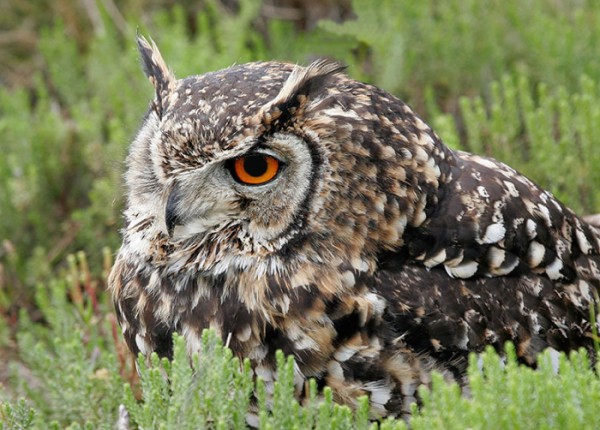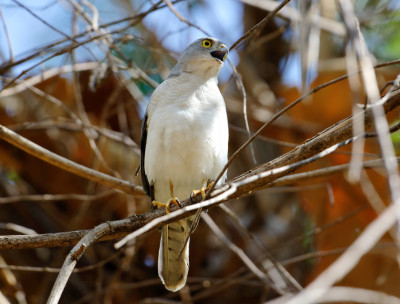Did You Know?
- In one study, more than 97% of prey items consumed by this owl were mammals.
How The Peregrine Fund is Helping
Darcy Ogada, the current director of our Northeast Africa Program, studied Mackinder’s Eagle-owls—a subspecies of the Cape Eagle-owl—in central Kenya. But there is still so much to learn about their ecology, especially outside of protected areas. Today, we study this species to learn as much as we can about it and to understand the impact of trade for belief-based use of the species. Additionally, in Kenya, our scientists are working hard to learn about and protect all raptors and their habitats. Through environmental education efforts, we are also working to put a stop to the common practice of poisoning carcasses to kill large predators, which also kills a host of wildlife including vultures, eagles, and other scavenging birds. These efforts will certainly benefit all raptors of the region. Learn more about our work in Africa to conserve raptors.
Meanwhile, our efforts in scientific research, habitat conservation, education, and community development help conserve birds of prey around the world. We also supply literature to researchers from our avian research library, which helps scientists around the world gather and share important information on raptor conservation. We also run the Global Raptor Impact Network which gives raptor researchers tools to more efficiently conduct their own studies while contributing to a global program. GRIN also provides citizen scientists a way to participate in raptor science and conservation.
Where They Live
The Cape Eagle-owl is found in the southern portion of Kenya and into southern Africa. They tend to live at higher elevations, between 2100 m above sea level up to around 2,500 m above sea level. This owl appears to avoid deep forest, and rather is most often found in mountainous terrain and wooded valleys, grasslands, and areas with small bushes or heather which it uses for nesting and roosting.
What They Do
A large owl, the Cape Eagle-owl is seemingly able to adapt well to human encroachment of their highland habitat. Like many owl species, this eagle-owl is primarily crepuscular (meaning it is active at dawn and dusk). So this owl hunts, flies, and otherwise goes about its business at night. During the day, it rests (or roosts) in trees, where it is well-camouflaged.
Why They Need our Help
This owl is categorized as a species of Least Concern. However, it still faces several threats that could have harmful effects on the population in the long-term. In Kenya, individuals die after being poisoned—often by consuming prey that has been exposed to pesticides or rodenticides. People also trap these owls to sell them or to keep them as pets. Finally, sometimes these owls collide with man-made obstacles in the landscape, such as vehicles, power lines, and fences. Because they nest on the ground, their eggs or young can sometimes be taken by other predators.
What They Eat
As you may expect, this large eagle is capable of hunting quite a bit of different prey items. Overall, it seems to feed primarily on mammals including rodents, such as the groove-toothed rats, and rock hyrax, hares, and it will also take bats. But its list of prey items doesn't stop there. It also hunts birds, reptiles, amphibians, and insects. When on the hunt, this owl might wait patiently on an exposed perch. When it spots prey, it might glide down to trap it in its sharp talons.
Nests, Eggs, and Young
Like most owl species, the Cape Eagle-owl does not construct a nest. Instead, the female will lay her eggs on a cliff ledge, inside a cave, or even on the ground—usually beneath some sort of vegetation cover. She will also sometimes use old stick nests built and abandoned by another large bird. The female will lay 1-3 eggs that usually measure around 55 mm × 45 mm. These eggs must be incubated for around 36 days. The female is generally in charge of incubating and otherwise caring for the eggs, while the male works hard to find, capture, and deliver prey to the female.
When the owlets hatch, they are covered in an off-white down, but they will grow quickly. They will begin to explore the area just outside the nest when they are only 45 days old. By the time they are around two months old, they will be ready to fly for the first time. But flying is just one step in all there is to learn to be an owl. The young birds will stay with their parents for 2–3 months after fledging, in order to learn how to hunt, avoid danger, and otherwise survive.
References
Holt, D. W., R. Berkley, C. Deppe, P. L. Enríquez, J. L. Petersen, J. L. Rangel Salazar, K. P. Segars, K. L. Wood, and J. S. Marks (2020). Cape Eagle-Owl (Bubo capensis), version 1.0. In Birds of the World (J. del Hoyo, A. Elliott, J. Sargatal, D. A. Christie, and E. de Juana, Editors). Cornell Lab of Ornithology, Ithaca, NY, USA. https://doi.org/10.2173/bow.caeowl1.01
Rödel, H.G., Scholze, W.W. and Kock, D., 2002. Diet of Mackinder's eagle owl Bubo capensis mackinderi in the alpine zone of Mount Kenya. African Journal of Ecology, 40(3), pp.283-288.
Sessions, P.H.B., 1972. Observations on Mackinder's Eagle Owl Bubo capensis mackinderi Sharpe on a Kenya farm. Journal of East African Natural History, 1972(138), pp.1-20.










